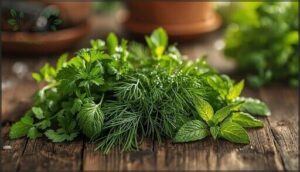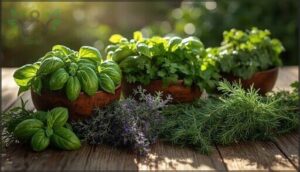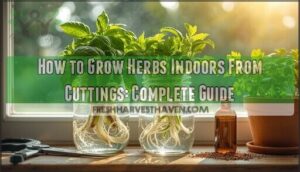This site is supported by our readers. We may earn a commission, at no cost to you, if you purchase through links.

Basil’s methyl eugenol delivers a sweet punch, oregano’s carvacrol brings heat, and rosemary’s 1,8-cineole creates that unmistakable woody kick your taste buds crave.
Learning which herbs for culinary use belong in your arsenal, when to deploy fresh versus dried, and how to coax out their maximum flavor potential separates confident home cooks from those still reaching for pre-mixed seasoning blends. Master the fundamentals of herb selection, storage, and application, and you’ll discover layers of taste that make every dish feel intentional.
Table Of Contents
- Key Takeaways
- Essential Culinary Herbs and Their Uses
- Culinary Herb Flavor Profiles
- Cooking With Fresh and Dried Herbs
- Storing and Preserving Culinary Herbs
- Growing Culinary Herbs at Home
- Frequently Asked Questions (FAQs)
- What are the top 10 herbs?
- What is the most versatile herb for cooking?
- What is the king of all herbs?
- What are the 10 most commonly used herbs?
- What herbs are best for cooking?
- What are culinary herbs?
- What are the 12 cooking herbs?
- What are the basic culinary herbs?
- Which herbs are used for cooking?
- What are the best fresh herbs for cooking?
- Conclusion
Key Takeaways
- Mastering a handful of essential herbs—basil, oregano, rosemary, thyme, parsley, cilantro, and mint—delivers transformative flavor through their distinct chemical compounds like methyl eugenol, carvacrol, and thymol, eliminating the need for pre-mixed seasoning blends.
- Fresh herbs work best in quick-cook dishes and finishing touches, while dried herbs excel in long-simmering preparations, with the critical conversion ratio of 3:1 (fresh to dried) for delicate herbs and 2:1 for dense varieties.
- Strategic storage extends herb potency significantly: woody varieties last 2-3 weeks wrapped in damp paper towels at 32°F, while proper drying at 35-43°C can increase basil’s phenolic content sevenfold and freezing retains up to 91% of β-carotene.
- Growing your own herbs demands matching specific conditions—basil thrives at 50-85°F, dill at 60-75°F, mint at 65-70°F—with harvest timing before flowering and during morning hours capturing maximum essential oil concentration.
Essential Culinary Herbs and Their Uses
You don’t need a dozen herbs cluttering your kitchen to cook like you mean it. A handful of essential culinary herbs will transform your dishes from bland to unforgettable, each bringing its own personality to the table.
Let’s break down the heavy hitters that belong in every cook’s arsenal.
Basil, Oregano, and Rosemary
Three powerhouse herbs anchor your flavor revolution. Basil brings a sweet, herbaceous punch through methyl eugenol and estragole—nearly 99% of its essential oil. Oregano delivers warm, spicy heat with up to 80% carvacrol content. Rosemary’s 1,8-cineole creates that unmistakable minty-woody kick. Understanding the culinary herb properties is essential for mastering these aromatic profiles.
Master these aromatic profiles:
- Basil: Sweet Italian pesto or Thai stir-fries
- Oregano: Mediterranean grilled meats and pizza
- Rosemary: European roasts and rustic breads
- All three: Global trade staples worth billions
Thyme, Parsley, and Chervil
You’re already rocking basil, oregano, and rosemary—now let’s discover thyme, parsley, and chervil. Thyme benefits include antimicrobial power from thymol, with parsley origins tracing back to Mediterranean rituals honoring renewal. Chervil uses extend from French béarnaise to digestive remedies.
These herb pairings enhance your culinary herbs game: thyme for roasted meats, parsley brightening Mediterranean dishes, and chervil’s delicate anise notes finishing refined sauces. Their medicinal properties? Pure bonus. For more information on thyme’s health benefits, explore the thyme health benefits to learn about its potential uses.
Cilantro, Dill, and Mint
Beyond thyme and parsley, cilantro benefits reach from bright citrus flavors to quercetin-powered skin protection, while dill recipes showcase anise notes perfect with seafood. Mint tea lovers tap menthol’s cooling magic, and herb gardening these three demands attention to fresh harvesting timing. Herb flavor profiles shift dramatically: cilantro thrives at 50-85°F, dill prefers 60-75°F, mint dominates at 65-70°F.
- Cilantro offers tart, citrusy brightness for Mexican and Asian cuisine
- Dill’s light anise character elevates vegetables and seafood dishes
- Mint delivers adaptable sweetness from desserts to savory curries
- Growing culinary herbs requires matching temperature ranges to species
Bay Leaf and Other Notable Herbs
Bay leaves anchor Mediterranean cooking with woody, eucalyptus-like aromatic profiles, while bay leaf benefits include eugenol’s anti-inflammatory punch and proven cholesterol reduction.
Herb blending pairs bay with oregano, rosemary, and thyme in Italian seasoning, commanding 3.1% of global herb markets projected at USD 1.48 billion by 2035.
Master herb storage methods—hot air drying at 60°C preserves essential oils better than traditional sun drying.
Culinary Herb Flavor Profiles
Understanding the flavor profile of each herb transforms cooking from guesswork into creative expression. Some herbs bring sweetness while others add earthiness, bitterness, or bright citrus notes that can make or break a dish.
Here’s how to match herb characteristics with the right foods, and which classic combinations have stood the test of time across cuisines.
Sweet and Savory Herb Characteristics
What makes sweet basil taste like sunshine while thyme hits with earthy punch? It’s all about aromatic compounds. Linalool shapes basil’s sweet profile at concentrations up to 39.8%, while thymol delivers thyme’s herbal bite.
Understanding these flavor profiles of herbs—from menthol’s cooling sweetness in mint to eugenol’s spice—transforms you from cook to flavor architect. Master herb chemical analysis, and you’ll discover culinary herb varieties like never before.
Mastering herb chemistry—from menthol’s coolness to eugenol’s heat—elevates you from cook to flavor architect
Herb Pairings for Different Dishes
When you’re pairing herbs with food, think regionally first. Mediterranean dishes thrive with oregano and thyme—they’re in 70% of traditional stews. Asian cuisines lean on cilantro’s citrus punch (85% of Southeast Asian soups), while Latin cooking demands that same herb for salsas.
Protein pairings matter too: rosemary dominates 65% of beef roasts, dill claims 80% of seafood recipes, and these flavor profiles boost preference scores by 30%.
Herb Combinations in Classic Cuisine
Classic cuisine builds on flavor synergy you can trace back centuries. Italian blends unite basil, oregano, and rosemary in 71% of pasta sauces, while French bouquet garni—parsley, thyme, bay leaf—infuses 78% of stocks.
Global blends like za’atar (2,000 years of historical usage) and garam masala show how regional variations evolve into modern adaptations that still honor their roots.
Cooking With Fresh and Dried Herbs
You can’t just toss herbs into a pan and hope for the best. Fresh and dried herbs behave differently in the kitchen, and knowing when to reach for each one transforms your cooking from guesswork to precision.
Here’s how to work with both forms like you actually know what you’re doing.
When to Use Fresh Vs. Dried Herbs
Fresh herbs versus dried herbs isn’t just about flavor intensity—it’s about knowing when each one steals the show. Use fresh herbs in quick-cook dishes and finishing touches, where their bright aromatics shine.
Dried herbs excel in long-simmering stews and braises, releasing concentrated flavors over time.
Remember: cooking duration matters more than cost comparison or herb availability when choosing your weapon.
Techniques for Adding Herbs to Dishes
Timing your herb addition unlocks flavor release like a pro. Toss delicate basil or cilantro in during the final 1–2 minutes to preserve aromatic punch, while hardier rosemary infuses throughout if added 20 minutes before serving.
Crushing dried herbs before cooking boosts volatile oil release by 30–35%, amplifying flavor enhancement. Test herb combinations in small batches—smart culinary applications demand balance, not brute force.
Herb Substitution and Measurement Tips
Swapping herbs without proper conversion charts can tank your flavor profiles faster than overcooking pasta. Master these Fresh-Dried Ratios to nail herb usage every time:
- 3:1 for delicate herbs—1 tablespoon fresh basil converts to 1 teaspoon dried, preserving flavor enhancement despite potency considerations
- Dense herbs need 2:1—rosemary concentrates aggressively, demanding Measurement Accuracy
- Crumble dried herbs—boosting Extract Standardization increases Flavor Impact by 18%
Strategic herb combinations demand precision, not guesswork.
Storing and Preserving Culinary Herbs
You’ve mastered the art of cooking with herbs—now it’s time to make sure they don’t wilt into oblivion before you get to use them. The difference between vibrant, flavor-packed herbs and sad, slimy greens comes down to how you store and preserve them.
Let’s break down the techniques that’ll keep your culinary herbs fresh, potent, and ready to transform your next dish.
Storing Fresh Herbs in The Refrigerator
To nail herb storage in your refrigerator, wrap woody varieties like rosemary in damp paper towels inside containers—they’ll keep for 2-3 weeks. Tender herbs prefer standing upright in jars with water, loosely covered.
Suitable containers allow airflow to prevent rot while managing herb moisture. Most fresh herbs thrive at 32°F, extending shelf life considerably.
Keep ethylene-sensitive basil away from ripening fruit to avoid accelerated decay.
Drying, Freezing, and Infusing Herbs
Beyond refrigeration, herb storage methods reveal concentrated flavors and extended usability. Drying temperatures between 35–43°C remove moisture while preserving potency—basil’s phenolic content actually increases sevenfold during proper herb preparation techniques.
Freezing methods maintain nutrients better than any alternative, retaining up to 91% of β-carotene after months.
Infusion benefits emerge when cooking with dried herbs releases bioactive compounds your body absorbs more readily than from raw leaves.
Maximizing Herb Shelf Life and Flavor
Once you’ve selected your drying, freezing, or infusing method, storage conditions become the difference between vibrant flavor and wasted potential. Best temperatures near 0°C extend herb shelf life three weeks, while packaging methods like vacuum sealing boost freshness 50%. Vapor treatments using acetic acid or tea tree oil offer eco-friendly protection. Sophisticated technologies—controlled atmosphere chambers, modified humidity systems—cut spoilage rates 40% in commercial applications, proving innovation transforms how we preserve these botanical powerhouses.
- Store most herbs at 0°C for maximum longevity
- Choose sealed, visible packaging over cramped containers
- Apply antimicrobial vapor treatments for natural preservation
Growing Culinary Herbs at Home
Growing your own culinary herbs puts you in control of flavor, freshness, and quality—no more wilted supermarket bundles or mystery pesticides. Whether you’re working with a sun-drenched backyard or a tiny windowsill, you can cultivate a thriving herb garden that delivers serious results.
Here’s how to choose the right herbs, master indoor and outdoor growing techniques, and harvest like a pro.
Choosing Herbs for Home Gardens
Starting your herb garden doesn’t require a green thumb—just strategic choices. Focus on beginner-friendly herbs like basil, parsley, and rosemary, which thrive in neutral soil and offer high disease resistance.
Consider space considerations: container-friendly herbs like mint and chives work brilliantly in tight spots, while perennial choices such as oregano deliver years of harvests.
Choose herbs matching your growing conditions, and you’ll transform your culinary game.
Indoor and Outdoor Growing Tips
Whether you’re building an indoor herb garden or outdoor plot, mastering light requirements and temperature control transforms success rates. Indoor herbs need 12–14 hours under grow lights for best yield, while outdoor varieties demand 6+ hours of direct sun.
Maintain 65–70°F daytime temperatures and 40–60% humidity. Well-draining soil suits most species, though basil prefers consistent moisture.
Monitor pest management weekly—aphids multiply rapidly indoors.
Harvesting and Preparing Homegrown Herbs
Timing your harvest transforms flavor intensity—cut leafy herbs before they flower, when morning dew dries but heat hasn’t peaked. You’ll capture maximum essential oils this way.
- Harvesting Techniques: Take up to 75% of annual growth or one-third of perennial stems using sharp pruners
- Washing Herbs: Rinse immediately in cold water, then dry thoroughly before cooking with fresh herbs
- Drying Methods: Hang small bunches in dark, ventilated spaces for one to two weeks until brittle
Frequently Asked Questions (FAQs)
What are the top 10 herbs?
The U.S. herbs market hit $76 billion in 2025.
Your essential ten are Basil, Oregano, Rosemary, Thyme, Parsley, Sage, Mint, Chives, Cilantro, and Dill—prized for global popularity, culinary versatility, and medicinal benefits.
What is the most versatile herb for cooking?
Basil stands out for its culinary herbs versatility—blending sweet, peppery notes with remarkable flavor enhancement across cuisines. Its flavor impact adapts brilliantly to cooking methods, from fresh finishing to dried infusions.
Herb combinations with parsley or thyme reveal deeper herb flavor profiles.
What is the king of all herbs?
Basil’s reign as the “king of herbs” stems from its historical significance, spanning over 5,000 years of global consumption and medicinal uses.
This long-standing tradition has cemented its market impact across essential culinary herbs and flavor enhancement traditions worldwide.
What are the 10 most commonly used herbs?
You’ll reach for basil, oregano, rosemary, thyme, parsley, cilantro, dill, mint, chives, and sage most often.
These culinary herbs dominate global herb usage, reflecting regional herb preferences and driving steady herb market growth worldwide.
What herbs are best for cooking?
You can’t go wrong with basil, oregano, rosemary, thyme, parsley, and cilantro—these cooking herbs deliver peerless flavor profiles and enrich virtually any dish. Their flavor compatibility spans cuisines while offering real health benefits and year-round availability.
What are culinary herbs?
Think of culinary herbs as nature’s secret weapon for transforming ordinary meals into remarkable experiences.
These aromatic edible plants—spanning global herb families and varieties—add concentrated flavor, depth, and complexity to dishes worldwide.
What are the 12 cooking herbs?
The twelve foundational cooking herbs you’ll master include Basil, Oregano, Rosemary, Thyme, Parsley, Chervil, Cilantro, Dill, Mint, Bay Leaf, Sage, and Tarragon—each offering distinct flavor intensities and culinary applications across regional variations.
What are the basic culinary herbs?
You might think dozens of herbs matter, but five anchor most kitchens: basil, parsley, oregano, thyme, and rosemary dominate culinary herbs worldwide, offering beginner-friendly cultivation and flavor intensity that spans regional variations across herb families.
Which herbs are used for cooking?
You’ll find basil, oregano, rosemary, and thyme dominating Western kitchens, while cilantro reigns globally across cuisines.
These culinary herbs offer distinct flavor profiles—from basil’s sweet aromatics to oregano’s peppery punch—transforming ordinary cooking with herbs into culinary mastery.
What are the best fresh herbs for cooking?
You’d think exotic herbs would be most important, but basil and cilantro dominate—comprising over 65% of fresh herb consumption.
Their versatility, aromatic intensity, and flavor enhancement capabilities make them essential culinary herbs across global cuisines.
Conclusion
Ironically, the simplest way to improve your cooking requires nothing fancy—just understanding herbs for culinary use. You’ve already got the knowledge: flavor profiles that guide pairings, preservation methods that lock in potency, and growing strategies that put fresh sprigs within arm’s reach.
Now ditch the guesswork. Treat herbs like the precision tools they are, not afterthoughts. Your meals won’t just taste better—they’ll reveal what intentional cooking actually feels like when you stop playing it safe.
- https://www.statista.com/outlook/emo/food/sauces-spices/spices-culinary-herbs/worldwide
- https://www.fortunebusinessinsights.com/culinary-herbs-market-111089
- https://www.coherentmarketinsights.com/industry-reports/dried-herbs-market
- https://www.researchgate.net/figure/The-12-leading-countries-of-import-and-export-of-medicinal-and-aromatic-plant-material_tbl7_226511498
- https://finance.yahoo.com/news/top-25-spices-producing-countries-070939081.html











